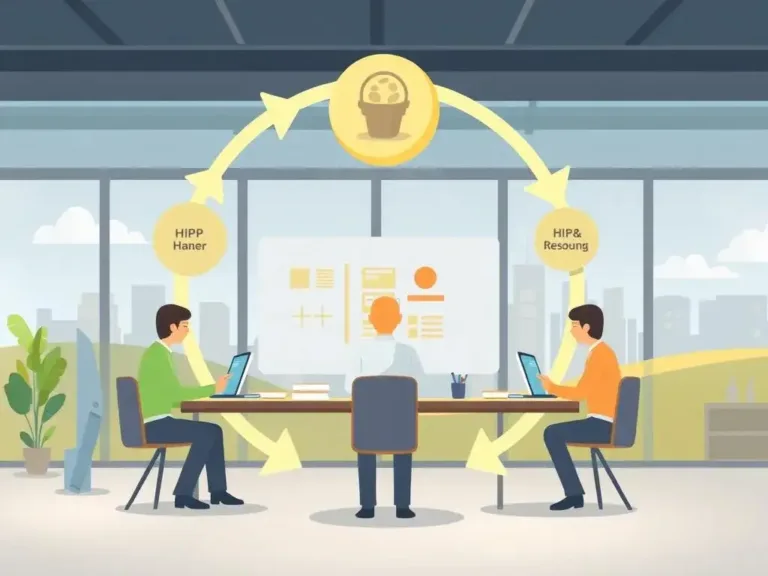Explore Human Resource Planning (HRP): meaning, objectives, strategic integration, benefits, challenges, & recent trends. Your complete guide to HR capital.
Human Resource Planning (HRP): A Comprehensive Overview
Human Resource Planning (HRP) is a critical organizational function that ensures the right number of qualified people are in the right places at the right time, contributing to both organizational and individual success. It’s a foundational element of Human Resource Management (HRM) and is also known as Manpower Planning, Employment Planning, Labour Planning, or Personnel Planning.
1. Introduction to Human Resource Planning
Human resources are vital to an organization’s functioning. They represent potential, abilities, and skills that develop through continuous interaction within the organizational setting. Effective utilization of human capital is crucial for productivity, company growth, and economic development. HRP plays a key role in matching job requirements with individuals at all stages, from recruitment to diversification and expansion. It also aligns with organizational plans, goals, and strategies.
2. Meaning of Human Resource Planning
HRP is a strategic process that guides an organization from its current to its desired workforce position. It involves anticipating future human resource needs and the available supply, then making necessary adjustments and developing the workforce to meet those needs. This includes not just the number of employees, but also their skills, knowledge, values, abilities, commitment, and motivation. Essentially, HRP translates organizational objectives into the required number and type of employees.
3. Definition of Human Resource Planning
HRP is the systematic process of reviewing HR requirements to ensure the availability of the right number of employees with the necessary skills when they are needed. It’s about getting qualified people into the right jobs, a challenge complicated by dynamic labor market conditions. HRP goes beyond simply matching supply with openings; it involves proactive efforts to identify and attract talent. Both line and staff managers share responsibility, with line managers estimating needs and staff managers providing supporting information and expertise.
4. Need and Importance of Human Resource Planning
HRP is crucial for several reasons:
- Assessing Future Personnel Needs: It prevents issues like surplus or shortage of labor, enabling organizations to proactively manage their workforce.
- Foundation for Other HRM Functions: HRP provides essential data for recruitment, selection, training, development, and promotion.
- Coping with Change: It helps organizations adapt to evolving business environments, including changes in technology, competition, and government regulations.
- Investment Perspective: Viewing human resources as an investment, HRP ensures proper planning for their development and utilization.
- Expansion and Diversification Plans: It identifies the exact personnel requirements for growth initiatives.
- Employee Turnover: HRP helps address and plan for the impact of employee departures.
- Conformity with Government Guidelines: It ensures compliance with regulations related to reservations and equal employment opportunities.
- International Expansion Strategies: HRP is vital for effectively managing human resources across global operations.
- Highly Talented Manpower Inventory: It helps attract and retain skilled and dynamic employees in a competitive environment.
5. Objectives of Human Resource Planning
The main objectives of HRP include:
- Accurately assessing future human resource needs.
- Anticipating and addressing manpower deficiencies or surpluses.
- Developing a highly talented workforce.
- Protecting vulnerable sections of society.
- Managing challenges arising from modernization and restructuring.
- Facilitating organizational objective achievement through optimal staffing.
- Reducing personnel costs through efficient planning.
- Determining future skill requirements.
- Planning career paths for employees.
- Providing top management with a clear view of HR dimensions.
- Identifying employee training and development needs.
6. Organization of Human Resource Planning
HRP is a collaborative effort. Line managers are responsible for their departmental manpower planning, while top management oversees the entire organization’s planning. The personnel department provides data, assists with transfers and promotions, and helps with forecasting techniques. They also coordinate control activities and report to top management for review and adjustments. Committees, often including external experts, may be formed to address deviations and implement corrective actions.
7. Factors Affecting Human Resource Plan
HRP is influenced by both external and internal factors:
- External Factors:
- Government Policies: Labor laws, industrial relations policies, and reservation policies.
- Level of Economic Development: Impacts HR development and supply.
- Business Environment: Influences production volume, mix, and HR demand.
- Level of Technology: Determines the types of human resources required.
- International Factors: Global demand and supply of human resources.
- Outsourcing: Availability of external expertise can reduce HRP dependency.
- Internal Factors:
- Company Policies and Strategies: Expansion, diversification, and alliance plans.
- Human Resource Policies: Quality of HR, compensation, and work-life balance.
- Job Analysis: Job descriptions and specifications define employee requirements.
- Time Horizons: Stability of the competitive environment influences planning duration.
- Type and Quality of Information: Accurate and qualitative information is crucial.
- Company’s Production Operations Policy: Impacts the number and type of personnel.
- Trade Unions: Influence working hours, recruitment sources, etc.
8. Human Resource Planning at Different Levels
HRP occurs at various levels:
- National Level: Government planning for the entire nation’s human resources.
- Sector Level: Manpower projections for specific sectors (e.g., agriculture, industry).
- Industry Level: Manpower needs for particular industries (e.g., cement, textiles).
- Unit Level: Estimating HR needs for a specific organization or company.
- Departmental Level: Manpower requirements for a particular department.
- Job Level: Forecasting needs for specific job families (e.g., Mechanical Engineer).
- Information Technology: Its impact on business necessitates multi-skilled, often fewer, experts.
9. Quantitative and Qualitative Dimensions of Human Resource Planning
Human resources play a dual role as both consumers and factors of production. Their growth is determined by quantitative and qualitative aspects.
- Quantitative Dimensions (Determining the Quantity of Human Resources):
- Population Policy: Policies influencing factors like fertility, marriage, and mortality, as well as responsive policies in health, education, and housing.
- Population Structure: Sex composition (ratio of males to females) and age composition (distribution by age groups).
- Migration: Net migration (immigrants minus emigrants) impacts population growth.
- Labor Force Participation: The number of economically active individuals (workers) in the population.
- Qualitative Dimensions (Assessing the Productive Power of Human Resources):
- Education and Training: The quality and quantity of formal and informal education and training.
- Health and Nutrition: Impact productivity, quality of life, and life expectancy, determined by purchasing power, public sanitation, and health knowledge.
- Equality of Opportunity: Addressing discrimination (social, economic, regional) to ensure equitable development and utilization of human resources.
10. Prerequisites of Human Resource Planning
Effective HRP requires:
- A strong link between HR plans and overall organizational plans.
- Support from top management.
- A balance between qualitative and quantitative approaches.
- Involvement of operating managers.
- Alignment between short-term and long-term HR plans.
- In-built flexibility to adapt to uncertainties.
- An appropriate time period for the HR plan.
11. Relationship of Human Resource Planning with Other Personnel Processes
HRP is deeply interconnected with other personnel management functions:
- Selection: All selection efforts are an integral part of HRP.
- Performance Appraisal & Training and Development: Appraisals identify skill gaps for promotions, and training addresses these needs.
Unlike non-human resources, “stockpiling” human resources is undesirable due to high costs, potential for boredom/frustration, and the social unacceptability of removing productive workers from the labor pool. Conversely, understaffing leads to overwork, frustration, and loss of efficiency. Effective HRP aims to prevent both extremes.
12. Cost-Contribution Analysis in Human Resource Planning
This analysis is crucial for planning an effective human resource system that maximizes employee contribution and minimizes costs. It involves:
- Determining Human Resource Components: Identifying necessary skills, abilities, dynamism, leadership, and commitment.
- Acquisition Measures: Planning recruitment, training, and development to acquire desired HR.
- Cost Streamlining: Treating human resource costs (remuneration, recruitment, training) as investments.
Human Resource Accounting (HRA), particularly the replacement cost of human assets, is a vital tool for manpower budgeting and planning.
13. Responsibility of Human Resource Planning
While the personnel department holds primary responsibility, it collaborates with the industrial engineering department, top management, and department directors. The Board of Directors has overall responsibility, directing the business’s future and setting goals for personnel policies. The personnel department recommends policies, devises procedures, determines quantitative aspects, assists management in objective setting, collects and summarizes data, monitors performance, and conducts necessary research.
14. Integration of Strategic Planning and Human Resource Planning
HRP should be a unified and integrated part of the overall corporate planning process. HR managers provide inputs on key HR areas, environmental constraints, and internal capabilities, while corporate strategists communicate their needs. This results in an integrated corporate strategic plan and HR plan.
Organizations formulate plans across four time spans:
- Strategic Plans (5+ years): Establish vision, mission, and long-range objectives. HRM raises broad HR policy issues.
- Intermediate-Range Plans (approx. 3 years): More specific plans supporting strategic goals. HR managers plan for future managers and key personnel.
- Operating Plans (approx. 1 year): Detailed monthly plans for profit, HR, budget, and cost control. HR plans support recruitment, compensation, job design, and work-life.
- Activity Plans (day-to-day/week-to-week): Daily business plans. HR plans address employee benefits, grievances, and disciplinary cases.
15. Human Resource Planning and Environmental Scanning
Environmental scanning helps understand the influence of internal and external factors on HR and business plans. Managers scan:
- Social Factors: Culture, religion, child-care, education.
- Technological Developments: IT, automation, robotics.
- Economic Factors: International, national, regional.
- Political Factors: Legal issues, laws, administration.
- Demographic Factors: Gender, age, literacy.
- Industry Growth Trends: Competition, new products, processes, innovations.
Internal environmental factors like organizational and employee cultures are also scanned through cultural audits. Benchmarking HR practices against industry bests helps achieve competitive advantage.
16. Human Resource Planning – Mapping an Organisation’s Human Capital Architecture
The link between strategy and HR should focus on developing core competencies – a portfolio of employee skills grouped by strategic value and distinctiveness:
- Core Knowledge Workers: Possess firm-specific, strategically linked skills (e.g., R&D). Companies invest heavily in their training and offer autonomy and higher salaries.
- Traditional Job-Based Employees: Skills are important but not unique (e.g., accountants). Less investment in development, more short-term financial benefits.
- Contract Labor: Skills of less strategic value (e.g., clerks, security). Hired externally, with transactional employment relations.
- Alliance/Partners: Unique skills not directly core to the organization (e.g., lawyers). Not regular employees, but long-term alliances are formed.
HR managers decide internal vs. external employment and the type of relationship based on cost-benefit analysis.
- Ensuring Fit and Flexibility:
- External Fit: Aligning business objectives with major HR initiatives (e.g., growth strategy with recruiting creative individuals).
- Internal Fit: Aligning various HR policies and practices for mutual reinforcement (e.g., integrated job design, recruitment, training, compensation).
Cohort Analysis: A clinical study design that monitors groups with similar characteristics over time. It helps separate growth from engagement metrics and identify growth problems, especially when case studies are not feasible.
17. Edgar Schein’s Human Resource Planning and Development System
Schein’s model emphasizes integrating HR planning with employee development, considering both company and individual needs. This approach results in superior outcomes for both parties. His system includes components like strategic business planning, job/role planning, manpower planning, HR inventorying, and various staffing and career development processes.
Internal Scan for HR Planning: When evaluating current HR capabilities, organizations should address:
- Key forces affecting operations (e.g., collective agreements, technology, budget).
- Existing knowledge, skills, abilities, and capabilities.
- The current internal environment (supportive and deterrent elements).
- Past and likely future changes in organizational structure, work type/amount, and technology.
- Changes in recruitment practices.
- Public perception of organizational quality.
- Contribution of current programs to organizational goals.
External Scan for HR Planning: To anticipate future labor market trends, an external scan should consider:
- Relevant elements of the current external environment.
- Specific issues and implications within the environment.
- Impact of local trends (demographic, economic, political, cultural, technology).
- Comparable operations and potential changes.
- Origin of the company’s work and potential changes.
- How the external environment might differ in the future and its implications.
- Trends affecting similar work in other jurisdictions.
- Trends affecting partners, stakeholders, and customers.
18. Human Resource Planning – Benefits
HRP offers numerous benefits:
- Checks the organization’s corporate plan.
- Mitigates uncertainties, ensuring the right people at the right time and place.
- Provides opportunities for employee advancement and development.
- Anticipates costs of salary enhancements and benefits.
- Facilitates budget formulation by forecasting HR costs.
- Helps foresee redundancy needs and plan for alternative employment.
- Anticipates changes in human resource values, aptitudes, and attitudes, prompting adjustments in management techniques.
- Plans for physical facilities, working conditions, and fringe benefits.
- Informs the design of selection tests and interview techniques.
- Develops various sources of human resources.
- Promotes increased productivity, sales, and turnover.
- Facilitates control over all HR functions, operations, contributions, and costs.
19. Human Resource Planning – Problems
Despite its benefits, HRP faces problems:
- Resistance by Employers and Employees: Employers may resist due to perceived cost increases or the belief that labor is readily available. Employees and unions may resist due to concerns about increased workload, external recruitment, or control over productivity.
- Uncertainties: Fluctuations in absenteeism, seasonal employment, labor turnover, and industrial factors (technology, market conditions) make HRP less reliable.
- Inadequacies of Information System: Lack of developed information systems in industries and insufficient reliable data on the economy, labor market, and HR trends.
20. Recent Implications of Human Resource Planning
Prior to the 1990s, the absence of proper HR plans, especially in the public sector focused on employment creation, led to:
- Overstaffing: Many organizations were overstaffed compared to international counterparts.
- VRS/Golden-Handshake: Programs implemented to reduce the consequences of overstaffing.
- Delayering and Downsizing: Organizational restructuring to rectify overstaffing issues.
21. Recent Trends of Human Resource Planning
Historically, HRP efforts were often inadequate, focusing on limited aspects like budgeting, management development, or personnel inventory. However, recent years have seen a shift towards more sophisticated HRP:
- Sophisticated Approaches: Personnel practitioners and researchers are emphasizing systems and contingency approaches and developing advanced forecasting models. This is partly driven by equal employment opportunity regulations.
- Factors Driving Sophistication: Larger and more complex organizations, increased interdependencies, and the advent of computers enabling complex analysis.
- Focus on Skilled Talent: The growing need for highly skilled managerial and technical talent requires longer lead times for training and development. Managers are increasingly recognizing HRP’s benefits.
Problems with Sophistication:
- Mathematical Complexity: Inherent complexity in modeling HR systems.
- Uncertainty and Acquisition Lead Time: Future HR needs are uncertain, and recruiting/training new personnel or promoting existing employees requires significant lead time. This is particularly challenging for highly skilled roles.
- Frequent Updates: HRP needs to be updated more frequently in unstable environments with greater uncertainty, especially for roles like research and development or marketing, demanding timely information and system support.













1 Comment